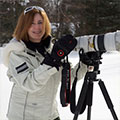Make a donation
The Museum is a charity and we rely on your support.
Make a donation today and support our 350 scientists who are working to build resilient habitats, protect vulnerable species and secure a sustainable future for our planet.

The plan was to drive out to photograph the northern lights over the icebergs in Jökulsárlón, Iceland.
But when she arrived, the sky was thick with cloud. 'Not expecting anything extraordinary, I set up close to the car, which was not an ideal location,' says Ellen. So when the clouds suddenly parted, revealing a breathtaking aurora borealis, she grabbed her gear and ran, stumbling in the dark, down to the water's edge. 'I was lucky,' she says. 'The aurora kept swirling, and I had time to set up again.' Lying on her stomach at the edge of the icy water, she used an extreme wide-angle lens to capture the reflection, and placed a lens cloth in front of part of the lens, then slowly raised it, to balance the exposure of the sky against the reflection (the magic-cloth technique). 'It was quite a challenge to force myself to think about the technical details while I was, in fact, feeling overwhelmed by the intensity of the display,' she says. 'This was my favourite image - the swirl of the clouds complementing the unusual colours in the aurora, all mirrored in the lagoon.'

USA
Ellen’s goal is to stimulate others to pause and appreciate the beauty and wonder of Earth. Her images are included in several collections, and have been showcased in galleries and used in numerous publications. She teaches, leads photographic and processing workshops, and is a member of the North American Nature Photography Association.
Help us harness the power of photography to advance scientific knowledge, spread awareness of important issues and nurture a global love for nature.

